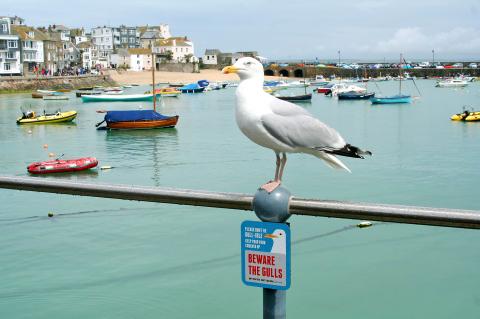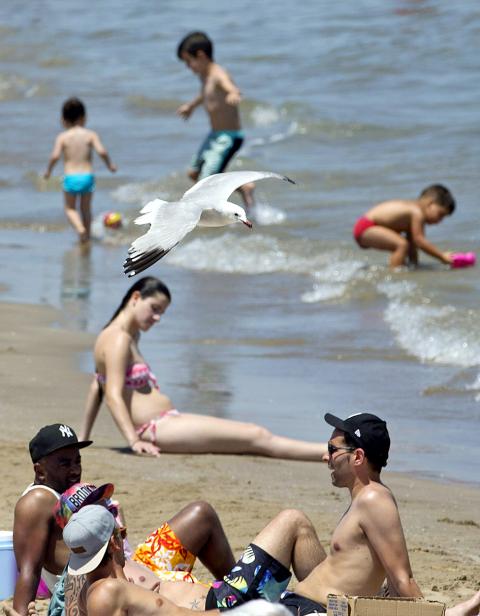The summer holidays are nigh and with them, no doubt, will come stories of seagulls on the rampage, stealing ice cream and chips and launching attacks on people and pets.
But a ground-breaking study that tracked the movement of herring gulls nesting in the Cornish resort of St Ives suggested they spent little time scavenging for goodies or scraps on the streets.
It turned out the four of the birds studied each had their individual ways of operating. Two of them habitually headed far out to sea, one flying as far as Wexford County in Ireland, while the others stayed close to St Ives but spend much more time foraging for food on farmland than in the resort.

Photo: Katherine Hadden/AFp
In all, the four birds completed almost 2,300 trips over 100 days during the breeding season of 2014 and traveled a total of more than 32,000km.
Peter Rock, the lead author of the study, said much was known about rural gulls but relatively little about urban-based one like these four.
“They have been under-studied so our knowledge of urban gulls is nowhere near as good as it should be. In view of the bad press surrounding urban gulls, it’s a situation that must change and this small study points the way,” he said.

Photo: Kai Fosterling/EP
Viola Ross-Smith, of the British Trust for Ornithology and a huge fan of gulls, said the findings showed that there could not be just one simple solution to the perceived problem of the birds.
“This study demonstrates that gulls behave as individuals and there can be no one size fits all approach when it comes to managing their populations,” she said. “It is vital that any decisions about gull conservation and management are based on the best scientific evidence available if they are to succeed.”
The study involved researchers attaching solar-powered GPS tags to the herring gulls, two male, two female, nesting on the rooftops of St Ives and tracing their movements through a summer.
It turned out the gulls, from four different nests, acted in very different ways. One of the birds, a male known as G4036, roamed widely, ending up as far afield as the Irish mainland and did not mind spending nights bobbing around out at sea. He was found to have visited Lundy island in the Bristol Channel and the Saltee islands off Wexford County.
A female called G4038 ranged primarily over land or within a mile or so of the shore but also occasionally took long trips out to sea.
By contrast, another female called G4037, which bred on the same roof as the prolific seafarer, and a male, G4039, rarely went more than a few hundred meters over water and then usually only to cross Carbis Bay on the way to the Hayle estuary. Their activity was concentrated during the day while the other two were out and about at night.
The data gathered revealed only occasional GPS fixes for the four in the streets of St Ives close to their nests, at which time they may have been picking up scraps of human food.
But they did spend much more time at a farm inland where there was a large heap of animal feed and in fields where they were probably hunting for invertebrates, small mammals, nestlings and amphibians disturbed by farm machinery during hay cutting and other farming activities.
The study is the first in which rooftop nesting herring gulls in the UK have been tagged and tracked.
Though gulls appear to be thriving in some areas, many species are in decline nationally, including the herring gull, which is on the UK red list for birds.
Gulls have been pointed to as a possible reason for a teenager falling from a harbor wall in St Ives on Tuesday. According to reports she was eating an ice cream and panicked when she attracted the attention of gulls.

The canonical shot of an East Asian city is a night skyline studded with towering apartment and office buildings, bright with neon and plastic signage, a landscape of energy and modernity. Another classic image is the same city seen from above, in which identical apartment towers march across the city, spilling out over nearby geography, like stylized soldiers colonizing new territory in a board game. Densely populated dynamic conurbations of money, technological innovation and convenience, it is hard to see the cities of East Asia as what they truly are: necropolises. Why is this? The East Asian development model, with

Desperate dads meet in car parks to exchange packets; exhausted parents slip it into their kids’ drinks; families wait months for prescriptions buy it “off label.” But is it worth the risk? “The first time I gave him a gummy, I thought, ‘Oh my God, have I killed him?’ He just passed out in front of the TV. That never happens.” Jen remembers giving her son, David, six, melatonin to help him sleep. She got them from a friend, a pediatrician who gave them to her own child. “It was sort of hilarious. She had half a tub of gummies,

The wide-screen spectacle of Formula One gets a gleaming, rip-roaring workout in Joseph Kosinski’s F1, a fine-tuned machine of a movie that, in its most riveting racing scenes, approaches a kind of high-speed splendor. Kosinski, who last endeavored to put moviegoers in the seat of a fighter jet in Top Gun: Maverick, has moved to the open cockpits of Formula One with much the same affection, if not outright need, for speed. A lot of the same team is back. Jerry Bruckheimer produces. Ehren Kruger, a co-writer on Maverick, takes sole credit here. Hans Zimmer, a co-composer previously, supplies the thumping

There is an old British curse, “may you live in interesting times,” passed off as ancient Chinese wisdom to make it sound more exotic and profound. We are living in interesting times. From US President Donald Trump’s decision on American tariffs, to how the recalls will play out, to uncertainty about how events are evolving in China, we can do nothing more than wait with bated breath. At the cusp of potentially momentous change, it is a good time to take stock of the current state of Taiwan’s political parties. As things stand, all three major parties are struggling. For our examination of the